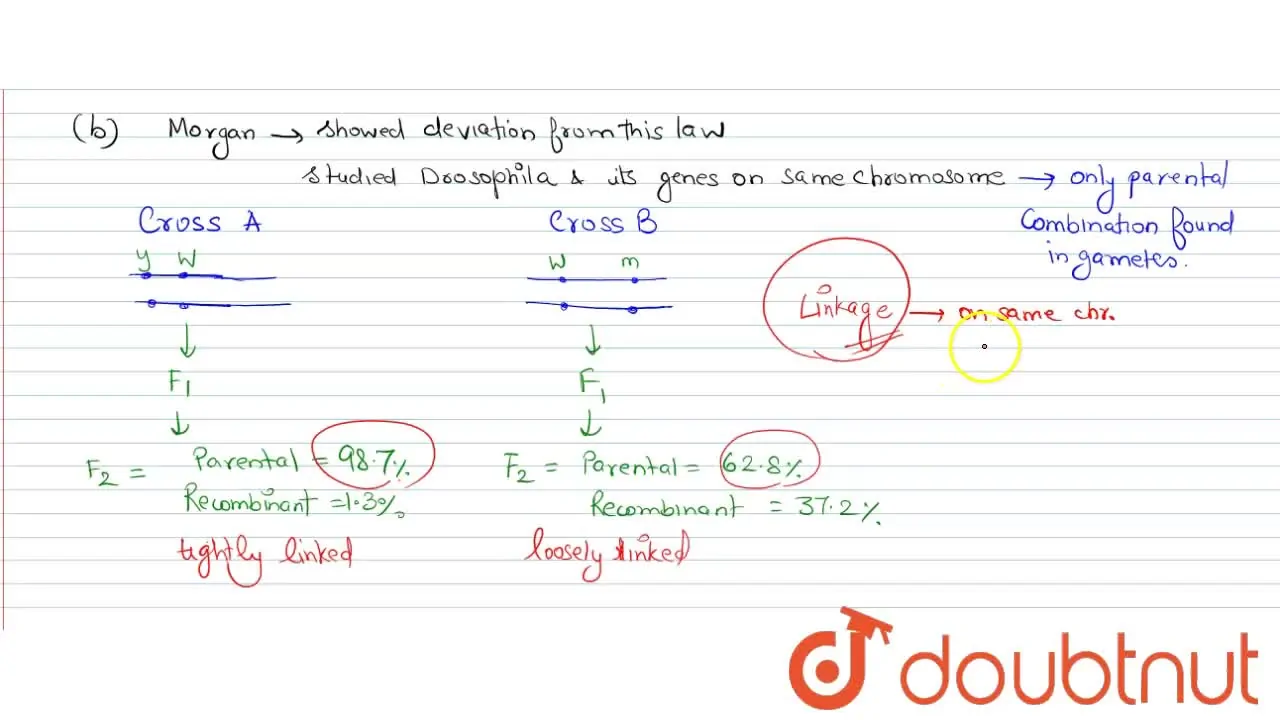(a) Explain Mendel's law of independent assortment by taking a suitable example.
(b) How did Morgan show the deviation in inheritance pattern in Drosophila with respect to this law?
(a) When a cross is made between plants {parents) differing in two or more pairs of contrasting characters, the inheritance of one pair of contrasting character is independent of the other pair of contrasting character. The two characters are transmitted independently in their own patterns. This law can be explained with the help of a dihybrid cross. A cross between two parents which differ in two pairs of contrasting characters is known as dihybrid cross. The cross can be made between true breeding parent plants one having yellow and round seeds (YYRR) and another plant having green and wrinkled seeds (yyrr). This cross is shown here under: To understand the Law of Independent Assortment study the formation of gametes in F, plant (RrYy). Consider the segregation of one pair of genes R and r 50% of gametes have the gene R and other 50% have r. In addition each gamete should also have the allele Y or y. We can see segregation of 50% Rand 50% r is independent from the segregation of 50% Y and 50% y. Therefore. 50% of r bearing gametes have Y and the other 50% y. Similarly,have Y and other 50% have y. Thus four different kinds If yy of gametes, ie.. RY. Ry, rY. ry are formed
(b) Morgan's experiment on Drosophila melanogaster (tiny fruit flies) Morgan hybridised yellow bodiedwhite eyed female flies with brown bodied-red eyed males and inter-crossed their F1 progeny. He observed that the two genes did not segregate independently of one another and the F2 ratio deviated very significantly 1from 9:3 :3: 1 ratio. Morgan knew that the genes were located on the X -chromosome and saw quickly that when the two genes in a dihybrid cross were situated on the same chromosome, the proportion green of parental gene combinations were much higher than the non-parental combinations Morgan attributed this to linkage or physical association of genes on a chromosome. The total number of genes present on one chromosome constitute a linkage-group. The genes are called linked genes.

Related Playlists
- BOOK - TRUEMEN BIOLOGY ENGLISHCHAPTER - GENETICS AND EVOLUTION EXERCISE - SECTION-C45videos
GENETICS AND EVOLUTION
- BOOK - TRUEMEN BIOLOGY ENGLISHCHAPTER - GeneticsEXERCISE - ASSERTION AND REASON122videos
Genetics
- BOOK - TRUEMEN BIOLOGY ENGLISHCHAPTER - HUMAN HEALTH AND DISEASEEXERCISE - MULTIPLE CHOICE QUESTIONS209videos
HUMAN HEALTH AND DISEASE
Similar Questions
State Mendel's law of Independent assortment.
View SolutionMendel's law of independent assortment can be demonstrated by
View SolutionMendel's law of independent assortment holds good for genes situated on the
View SolutionMendel's law of independent assortment holds good for genes situated on the
View SolutionLaw of independent assortment can be explained with the help of
View SolutionLaw of independent assortment of Mendel was proved by :-
View SolutionState and explain the "law of independent assortment" in a typical Mendelian dihybrid cross.
View SolutionState and explain law of multiple proportions with a suitable example.
View SolutionState Mendel's First law of inheritance and explain with the help of a suitable example.
View SolutionState Mendel's Second law of inheritance and explain with the help of a suitable example.
View Solution


